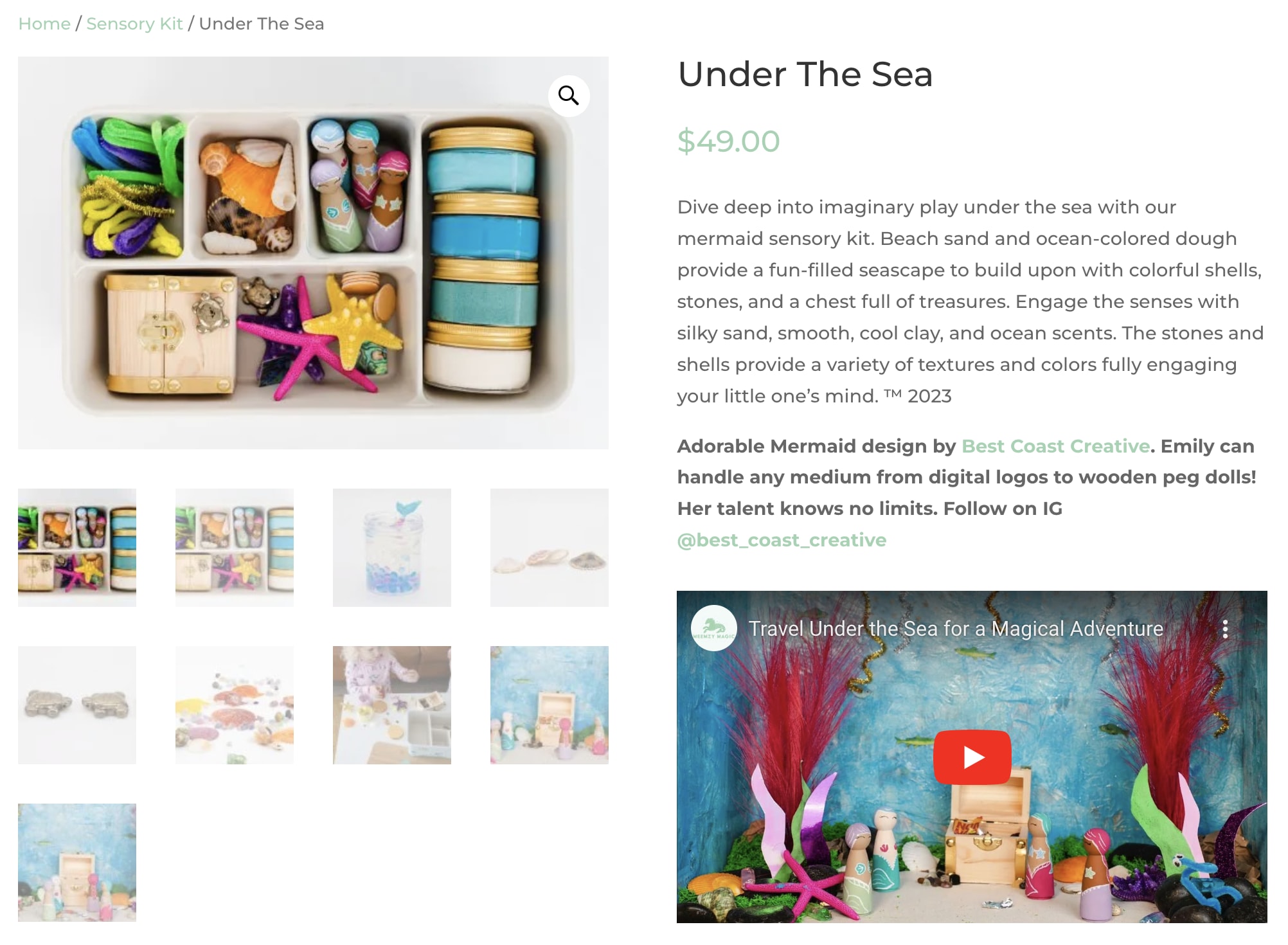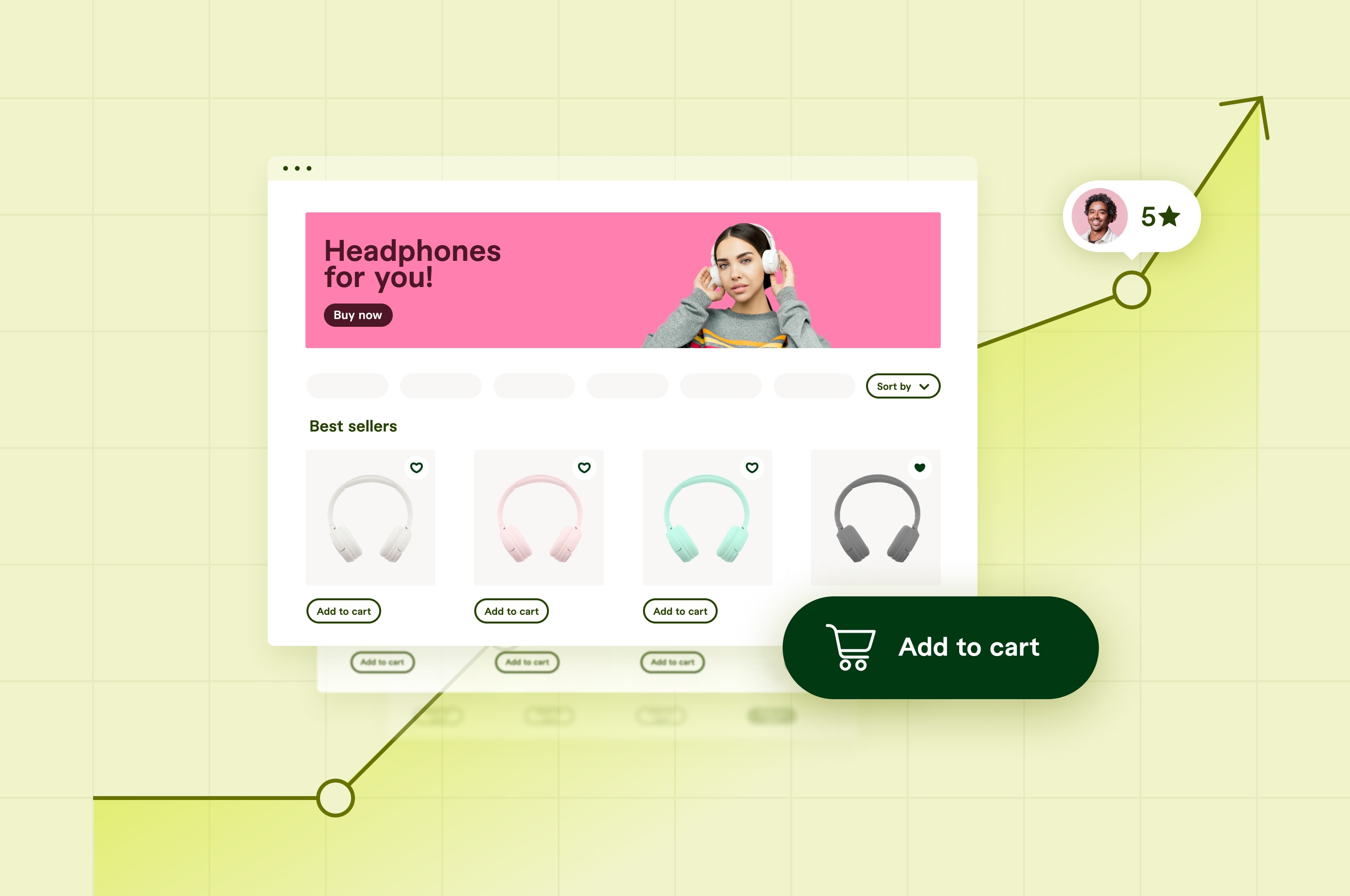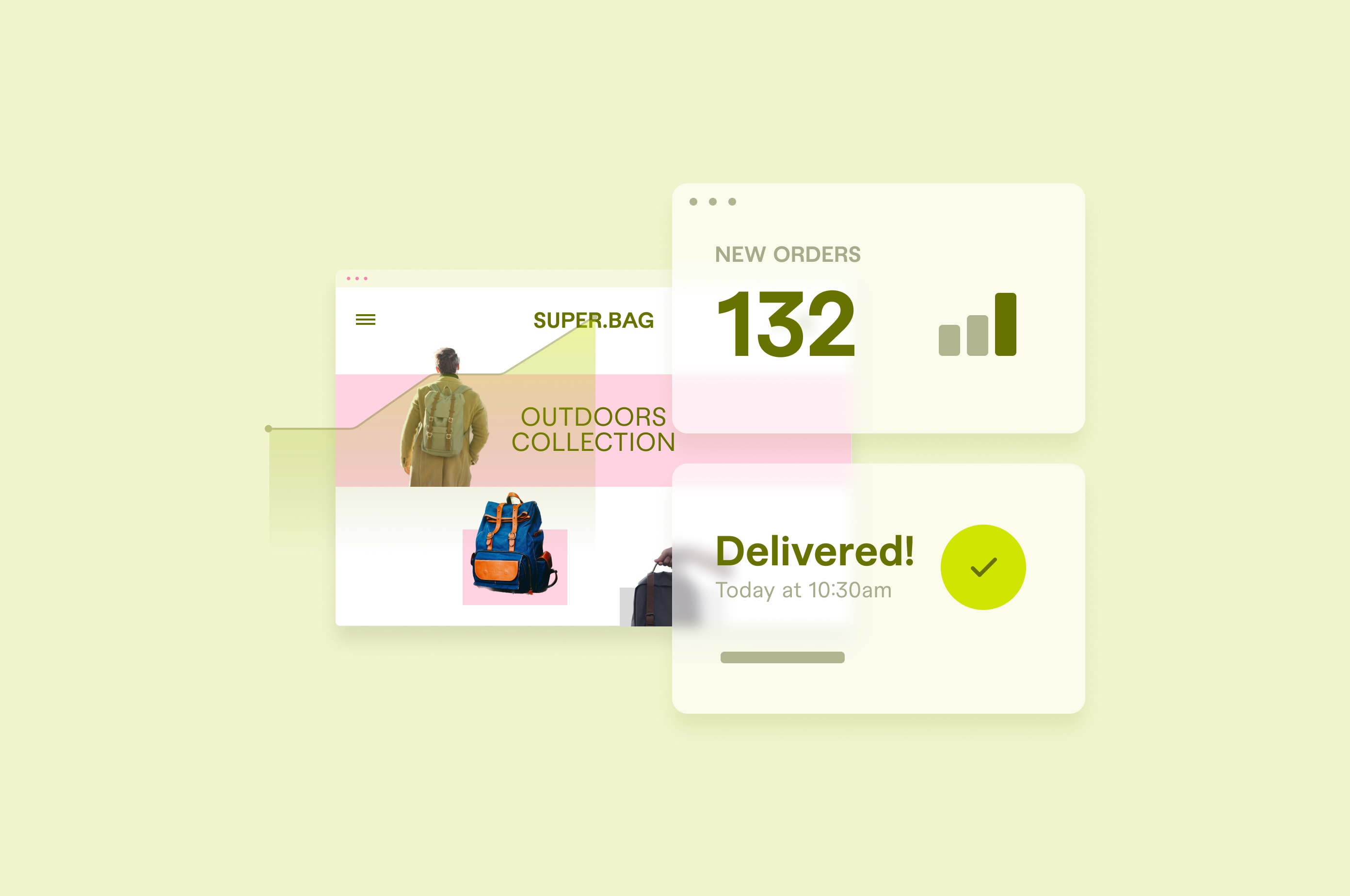How to start an ecommerce business in 2024: 5 Simple Steps
Learn how to launch your own online business in five simple steps and how to optimize your ecommerce marketing strategy.
 January 2, 2024
January 2, 2024 7 minute reading
7 minute reading
Thanks to the power of digital marketing and online marketplaces, almost anyone can start and grow a successful ecommerce business in 2024. It’s estimated that retail ecommerce sales will reach approximately $8.1 trillion by 2026, so is an optimal time to start your own business.
What is an ecommerce business?
An ecommerce business is a type of business model that allows entrepreneurs to sell products and services through online marketplaces—no physical storefront needed. Ecommerce businesses can range from small independent startups to large corporate enterprises. Some choose to market as business-to-business (B2B) companies, while others function as business to consumer (B2C).
Some examples of B2B products and services include:
Software-as-a-service (SaaS)
Subscriptions
Parts for other businesses to use
Consultants
Some examples of B2C products and services include:
Jewelry
Clothing
Beauty supplies
Health and fitness
We’ve written a step-by-steproadmap to help you start your ecommerce business and strengthen your ecommerce marketing strategies.
Hire a marketing research expert on Fiverr
1. Research and brainstorm your ecommerce business idea
A great idea is the cornerstone of any business—whether you sell online or in a brick-and-mortar store. With so many digital products just a click away, it’s important that your product idea is well thought out and memorable.
A great ecommerce business idea—one that you’re going to enjoy selling while still making a profit—has two distinct qualities:
It has proven market demand
It’s something you’re passionate about
“The advice I wish I received was to pick a product or niche you actually enjoy,” says Zachary Murray, founder of Nomadic Fabrics and founder of Foreplay. “Success comes through obsessing about your product and customer. Although I enjoyed building the brand, I personally found it hard to connect with our female customer segment over time, which made me fall out of love with the product and business.”

Nomadic Fabrics is an ecommerce business that sells home décor inspired by travels and stories.
For many small business owners, personal and professional lives aren’t separate. If you’re going to spend a lot of time with your ecommerce business, it’s important to ensure you enjoy working with your target market and care about the types of products you’re selling.
If you’re unsure what products your new business should sell, check out our list of the 10 best ecommerce product ideas. Check out Google Trends, and keep an eye out for inspiration during your daily life.
“When I decided to start Nomadic Fabrics, I was looking for trends around me. One weekend I was at a yoga festival and saw a huge line in front of a vendor’s booth—they were selling Turkish towels,” says Murray. “Seeing the demand in person got me fired up and, at the time, there were no solid options on Amazon, leading to me launching Nomadic Fabrics.”
When you’re happy with the products you want to sell, brainstorm a business name that reflects the mission of your ecommerce brand. A good brand name should be memorable and relevant to what you sell. Then, it’s time to write a business plan.
2. Decide whether to source or develop products
The decision between developing and warehousing your products versus sourcing them through dropshipping is an important one. Before choosing between these two options, you need to have an in-depth understanding of both your customer base and the competition. This will help you inform what makes the most sense financially and strategically.
Dropshipping
Sourcing existing items from manufacturers and suppliers often is quicker and more economical in the short term. There are lower upfront costs associated with this kind of ecommerce business model, which is why starting a dropshipping business in 2024 is such a popular option.
When partnering with a dropshipping supplier or print-on-demand company, be sure to verify their business licenses and any associated taxes and shipping costs, depending on the country you’re both located in. When done correctly, dropshipping is a great way to increase profit margins. Check out our ecommerce dropshipping article for more dropshipping tips and tools.
“Like with any bootstrapped business, cashflow at the beginning was a huge constraint,” says Murray. “We relied on a local dropshipping model to allow us to invest in marketing rather than tying it up in inventory.”
Reasons you might want to consider dropshipping include:
You have less upfront capital
It makes sense for the products you’re selling
Many of your competitors source their products

Pros and cons list of dropshipping versus developing products.
Developing
Developing something unique may give you a competitive advantage, which is beneficial for the long term. Another huge benefit of developing and keeping inventory yourself is that you are in control of all of the shipping and quality control. This helps you avoid any unhappy new customers if things were to go wrong with a supplier.
When starting your own ecommerce business, developing products yourself may seem like a daunting task. You can always enlist the help of freelance product designers to design and create any kind of product, from concept to 3D design to manufacturing.
“I saw the most adorable toys that were readymade and ready to ship. However, when I started [my] company, I promised myself I’d be as sustainable as possible,” says Jennifer Stalley, founder and president of Meemzy Magic, a sensory kit toy company. “In a world where anyone can start dropshipping tomorrow, I swam against the stream, crafting beautiful, heirloom quality, sustainable toys from nothing.”
Reasons you may want to consider developing include:
You have more upfront capital
You want to oversee shipping and quality control
You want to stand out from your competitors in the space

Example of a product kit sold by Meemzy Magic, a company that didn’t go the dropshipping route.
3. Set up your online store
The first step to creating an attractive ecommerce website is choosing the right platform. While you can create an ecommerce site by yourself, we recommend taking advantage of one of the many ecommerce platforms available.
“I’d personally recommend Shopify for three reasons: it’s super easy to use, it’s affordable, and the free themes and checkout flow are built for conversion,” says Fintan Meagher, founder of KPop Warehouse and content marketer at ReConvert.Shopify also has amazing scalability—so as your store grows, you’ll never run into capacity issues.”
Many types of ecommerce platforms exist, from basic web hosting services to solutions with advanced features and customization options. When selecting an ecommerce platform, consider factors, such as pricing, scalability, ease of use, features, and security.
The most popular ecommerce platforms include:
WooCommerce
Wix
BigCommerce
Adobe Commerce (formerly Magento)
Many platforms offer pre-made themes or templates that allow you to customize your online store quickly and easily, without any coding knowledge required. To maximize your ecommerce sales, include product pages with clear descriptions and high-quality images. Make sure your domain name appropriately reflects your brand as well as the items you’re selling.
After setting up the necessary components of your ecommerce store, it’s important to test its functionality before launching it publicly. This includes:
Making sure all products are displaying correctly
Testing out payment processing options with various credit cards or other payment methods
Ensuring the site speed is fast to avoid search engine optimization (SEO) penalties—a common ecommerce SEO mistake
Verifying customer support channels work—including your ecommerce chatbot
Making sure products can be added to the shopping cart without glitches
Also, consider distributing your products on online retailer providers such as Etsy, Amazon, and eBay for increased visibility.
4. Promote and market your ecommerce business
By now, you should have a solid understanding of your target audience and be able to create detailed customer profiles that will help shape your marketing strategy. There are a few different ways to market and promote, and you should choose the channels that make the most sense for your consumer base.
Content marketing
Stand out from competitors with creative and original content. You can create content yourself or partner with a freelancer to create shareable content.
Consider creating and marketing content through the following channels:
Social media content. Depending on the age of your target demographic, consider posting on Facebook, LinkedIn, TikTok, or Instagram. This gives you the ability to post a variety of content, including photos and videos, as part of your social media marketing strategy.
YouTube videos. If you’re a YouTube creator, consider joining Fiverr’s Influencer program and turn your influence into additional income. You can even monetize your YouTube channel and make additional revenue for your business that way.
Blog posts. Written content is a great way to engage your audience and provide some educational/informative material. You don’t need to allot a bunch of your time to it either—freelancers can help with articles and blog posts, or you can try out different AI tools to streamline the process.
Email marketing. Set up automated emails for when you launch a new product or offer a seasonal discount. You can also set up emails for situations like cart abandonment, or these other seven email marketing examples.
Influencer marketing
Influencer marketing can be a powerful tool for building credibility while reaching potential customers. Sixty-nine percent of consumers are more likely to trust an influencer, friend, or family member than information from an online business. Use this to your advantage by partnering with relevant, reputable influencers. Enlist the help of a freelancer to learn about the influencers in your market with strategy and research services.
“Today, many influencers are overhyped, while others present false numbers to get deals. To choose the right influencers, we’d spend a lot of time filtering their profiles based on industry, engagement rates, and other interesting parameters,” says Dan Troha, CEO and founder of Softball Ace, a premier platform that evaluates and disseminates information about softball games and gear. “This was a tedious and challenging task. Today, things have changed—we employ AI search analytics that helps us filter large volumes of social media data to identify the best influencers to fit a campaign and help take it to the next level.”
SEO marketing
Putting time into SEO can increase your organic visibility on search engine results pages. Here are some tips to get started with SEO marketing:
Conduct keyword research
Insert relevant keywords into page titles
Write unique metadata descriptions
Create quality content
Avoid keyword stuffing
5. Optimize your ecommerce business for success
It seems like the work never ends when you’re a small business owner. If you want your ecommerce business to succeed and eventually scale your operations, invest in optimization tools and strategies. Both AI and freelancers can optimize your business for success.
Artificial intelligence tools
Various AI tools can automate tedious parts of your day-to-day life. Here are creative ways to employ AI:
Polish your marketing videos with AI video editors
Power your social media strategy with AI content creation tools
Supercharge your coding productivity with AI coding tools
Create quality images for your branding with AI prompt ideas
If you’re unsure how to get started with AI—or don’t have the time to learn another business-oriented skill, find an AI freelancer who can accomplish the work for you. Check out additional AI use cases for small business owners here.
Partner with Fiverr freelancers
You don’t need to be a jack-of-all-trades—or handle a 10-person team—to run a successful ecommerce business. Working with freelancers allows you to hand off certain tasks without paying for full-time employees whom you may not have enough work for.
Join Fiverr to access a marketplace of talented, expert freelancers who can do everything from a social media marketing strategy to market research to website content.



